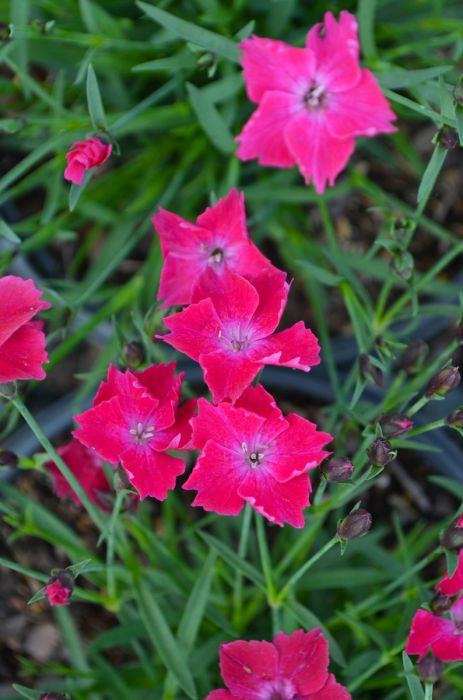Dianthus, Kahori® 'Scarlet'


Out of stock
Sold out for the season- Sun Preference
- Full-Sun, Part-Sun
- Bloom Time
- June, July, August, September
Description
Lovely flowers that are deep pink with white centers, covering mounds of fine foliage; great for flower arrangements; reblooms; pair up with summer blooming perennials and annuals to time a continued flower display
- Zone: 3-8
- H 6-8" W 10-12"
- June-Sept
Minnesota's Largest Selection of Perennials
Discover an unparalleled selection of perennials at Gertens! With the largest variety in Minnesota, we offer endless options of colorful perennials, natives, and pollinator plants to beautify your garden year after year. From vibrant flowers to lush foliage, our perennials are perfect for adding beauty and charm to your outdoor space. Visit Gertens today and see why we're known as Minnesota's Destination Garden Center!
Details
Plant Height: 8 inches
Flower Height: 12 inches
Spacing: 8 inches
Sunlight:![]()
Hardiness Zone: 3a
Other Names: Border Pinks, Cheddar Pinks
Description:
Lovely flowers that are deep pink with white centers, covering mounds of fine foliage; great for flower arrangements; reblooms; pair up with summer blooming perennials and annuals to time a continued flower display
Ornamental Features
Kahori Pinks is smothered in stunning fragrant hot pink frilly flowers with white centers at the ends of the stems from early to late summer. The flowers are excellent for cutting. Its attractive narrow leaves remain bluish-green in color throughout the year. The fruit is not ornamentally significant.
Landscape Attributes
Kahori Pinks is an herbaceous evergreen perennial with a mounded form. It brings an extremely fine and delicate texture to the garden composition and should be used to full effect.
This is a high maintenance plant that will require regular care and upkeep, and is best cleaned up in early spring before it resumes active growth for the season. It is a good choice for attracting bees and butterflies to your yard, but is not particularly attractive to deer who tend to leave it alone in favor of tastier treats. It has no significant negative characteristics.
Kahori Pinks is recommended for the following landscape applications;
- Mass Planting
- Rock/Alpine Gardens
- Border Edging
- General Garden Use
- Container Planting
Planting & Growing
Kahori Pinks will grow to be about 8 inches tall at maturity extending to 12 inches tall with the flowers, with a spread of 12 inches. When grown in masses or used as a bedding plant, individual plants should be spaced approximately 8 inches apart. Its foliage tends to remain low and dense right to the ground. It grows at a medium rate, and under ideal conditions can be expected to live for approximately 10 years.
This plant should only be grown in full sunlight. It prefers to grow in average to moist conditions, and shouldn't be allowed to dry out. It is not particular as to soil type or pH. It is highly tolerant of urban pollution and will even thrive in inner city environments. This particular variety is an interspecific hybrid. It can be propagated by division; however, as a cultivated variety, be aware that it may be subject to certain restrictions or prohibitions on propagation.
Kahori Pinks is a fine choice for the garden, but it is also a good selection for planting in outdoor pots and containers. It is often used as a 'filler' in the 'spiller-thriller-filler' container combination, providing a mass of flowers and foliage against which the thriller plants stand out. Note that when growing plants in outdoor containers and baskets, they may require more frequent waterings than they would in the yard or garden. Be aware that in our climate, most plants cannot be expected to survive the winter if left in containers outdoors, and this plant is no exception. Contact our store for more information on how to protect it over the winter months.
| SKU | Container Size |
| P1534 | #1 Container (1 Gallon) |
* Not all container sizes may be available at this time. See store for details on specific container size availability.
More Information
| Common Family Name | Dianthus |
|---|---|
| Gerten Grown Plants | Gerten Grown Plants |
| Available for Pre-Order | No |
| Sun Preference | Full-Sun, Part-Sun |
| Bloom Time | June, July, August, September |
| Mature Spread (Range) | Under 12" |
| Mature Height (Range) | 7-12" |
| USDA Hardiness Zone | 3, 4, 5, 6, 7, 8 |


